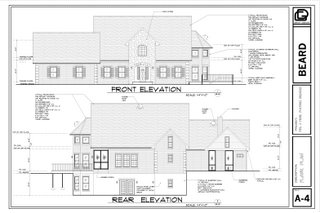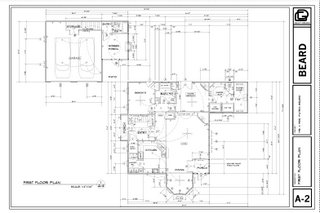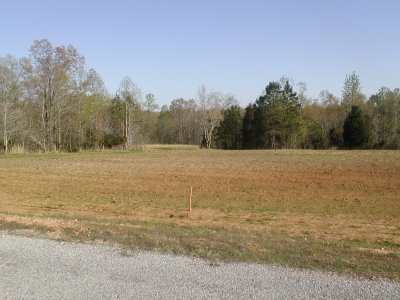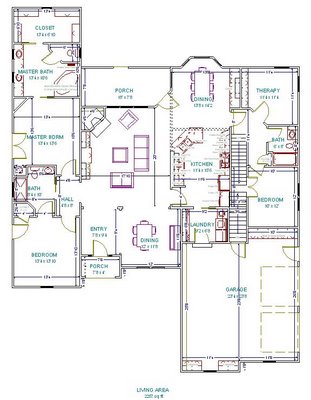Thursday, November 16, 2006
The land is For Sale
I hated to put it on the market, but it is becoming obvious that we simply cannot build our dream home 20 miles away from the hospital, my office, our church and our support network.
It is back to the drawing board concerning our future housing, but God knows our needs and I am confident that He will provide what we need.
If you are interested in this piece of property look it up on www.JAAR.net and do a search under Realtor Jim Hart.
Thursday, August 03, 2006
Sydney Cottage - 2,200 sqft
Picking the right plan and the right builder.
The plan that I have now (another custom design of mine) consists of 2,200 heated sq ft, with an unfinished space upstairs (as opposed to finished space) and a partial basement (instead of a full basement). The main floor has an open floor plan, four bedrooms, three baths and a two car garage. The basement and second floor will not be accessible, but should afford a safe room (for tornados) and additional living space for the future. We should be able to meet our families current needs and we have room to expand. So far while we have had to reduce the square footage we have not had to sacrifice esthetics for the sake of function, nor function for the sake of space. LORD willing, this is a plan we can build.
The next step is to find the right contractor to build the project. In West Tennessee you might expect to pay anywhere from $65 to $120 per sq ft for a nice custom built home (ceramic tile, crown molding, etc.). I understand that this is much less than other parts of the country. Although the old saying, "you get what you pay for" may be true, but just because a builder charges more does not mean that you will get more. The task now is to find the right builder for the right price and this will require some leg work.
Wednesday, July 19, 2006
Back to the drawing board...
It is humbling to publish my errors, but I think it is important to pass along the lessons learned for the people that may benefit from them.
The land has been purchased, plans have been drawn and estimates have been collected. The sad fact is that building this particular house would make us "house poor". The cost of building the actual home in this part of Tennessee would approach $225,000.00 -- this would not include fencing, barn, landscaping, etc. We simply cannot afford to build this house and live in it.
I have lost money on blueprints that I will not use, but I have been able to avoid the more costly error of over building. So, it is back to the drawing board.
After pouring my heart into a custom plan I am back to looking over stock plans with an eye at altering them for handicapped accessibility. The goal is to stay under 2,200 heated sq ft (originally 2,800). This should bring our building costs down with a projected 21% savings.
Tuesday, July 04, 2006
The Houseplan - The Bremerhaven

First Floor (Front of home faces North)

Second Floor (with Unfinished Space above Garage)

This is a "check copy" of the floor plan and there are some minor corrections that still need to be made. You will notice there are some major changes from the original floor plan.
Concerning the First Floor one major change was to "flip" the main house. This caused us to lose the Mudroom that connected the garage to the main house. The lay of the land is a slight slope to the southwest, so by flipping the main house we gained a better view and we were able to take advantage of the slope to have a walk-out Basement. The Mudroom was replaced by a smaller Laundry Room off the Kitchen.
We decided to keep the Screened Porch off the Garage and the Outdoor Fireplace. This porch provides an outdoor sitting area and an entry to the Future Apartment or Office located above the Garage. We also added a small Bath that can be used as the bath for the apartment/office and can also be accessed as a Pool Bath should a pool be added to the south of the Garage. The outdoor fireplace can be configured to add an Outdoor Kitchen or grill on the opposite side.
The Second Floor has Three Bedrooms and one Bath. There is also a small Study/Bedroom above the Entry below (this room could be deleted to provide a more dramatic entry). The addition of a small Laundry makes clothes washing easier and also provides for a Future Apartment situation on the second floor for a caregiver or guest. Just for fun there is a small Study off of one bedroom (just above the dinning area) which gives the exterior a castle tower like appearance.
The Basement (not pictured) is an additional 1,600 +/- square feet of unfinished space. There is a Full Bath with a Roll-in Shower. The unfinished basement provides room for a Family Room, Guest Room, Exercise/Therapy Room or whatever you design.
Monday, July 03, 2006
The blueprints are done!
I spoke to the architect, that helped with this design, about selling copies of the blueprints over the internet for families like mine. I own the copyright so there would be no problem with this and he said he would be willing to take this plan and change it to meet other's specific needs for an additional fee.
So, I am planning to put this plan on the blog here for you to look over and get ideas. If you use this plan I trust that you will pay for it. You can order a set of prints (floorplans and elevations) from me for only $300 plus $24 S&H (reproducible check set - 6 pages). Send me an email for details at indigenousoutreach@juno.com.
Tuesday, June 27, 2006
The original concept - The Bremerhaven

The inspiration for the exterior of The Bremerhaven was a home actually located in Bremerhaven, Germany.
The original concept for this Americanized plan includes two bedrooms and two and 1/2 baths on the main floor with three additional bedrooms and a full bath on the second floor. Borrowing from a common German design for a duplex the second floor could serve as a separate 2 bedroom apartment in the future with very few renovations.
The Master Bedroom and Second Bedroom are both handicapped accessible with emergency exits to an adjoining porch. The location of the bedrooms allows for easy access to each other (for those late night sleep interruptions that require caregiving). The Second Bedroom could also serve as a Study.
Both full Baths on the main floor are handicapped accessible. The Hall Bath has a roll-in shower, grip bars near the toilet and enough floor space to turn a wheelchair 360 degrees. A nook has been added in later versions to accommodate a bath chair and provide storage. There was a small Powder Room (or 1/2 bath) off the Foyer in the original plan that has been replaced with an elevator because of the addition of a Basement.
A detached garage is accessed through a screened porch and mudroom. Detaching the garage from the main house allows for accessibility without the danger of CO2 poisoning (Most garages are lower than the main floor of a home. Accessible garages are on the same level as the main floor reducing the need for ramps). The Mudroom is attached to a small Office (that was lost in a later version of the plan). The final version of the Bremerhaven has flipped the main floor, but left the garage on the eastern side of the home. The office (replaced by a small upstairs room above the foyer) was converted into a laundry area, the mudroom was lost (replaced in the basement) and the screened porch became accessible just off the bedroom porch. This change was necessary because of the lay of the land and the desire to have a walk-out basement.
There was no Basement in the original concept as the goal of the plan was for accessibility. However, the latest version of the plan includes a full walkout Basement accessed by stairs and a small residential elevator. The addition of a basement gave 1,700 extra square feet of possible living space for only about $12,000 more than a conventional foundation. Future plans for the basement include a Family Room, Guest Room, Therapy/Exercise Room and a full Bath with roll-in shower.
Although I personally do not like an open floor plan it was a better option for accessibility. Interior walls were kept to a minimum and narrow hallways were avoided by making most "halls" into usable rooms. All doors measure 36". Most rooms of the house have enough floor space for a wheelchair to turn completely around 360 degrees (approx 5' circle).
Passive Solar ideas have been incorporated into the houseplan as the back of the home faces the south; the living areas on the main floor and the basement have large south facing windows. Solar panels could easily be added to the roof for added efficiency.
The home has been designed to accommodate two high efficiency split air conditioning units. Each floor has a utility area for the A/C units. The basement has the same utility area that can accommodate an infloor heating system.
I plan to offer the finished blueprints for sell once the project is completed. So, the plan has been copyrighted.

Start with the right piece of land

Our objective was to purchase enough land (3 acres) upon which we could build a handicap accessible home, have a horse (mainly for therapy) and stay close to town where doctors, therapists and friends are located. Other perks would be lots of trees, hills and protective covenants. I also wanted the back of the house to face south so that we could incorporate some passive solar aspects into the design.
After looking, considering and praying for two years we found 76 Sydney Lane. We have 10 acres of rolling hills with hundreds of trees! There are three fairly level fields on the property and a place where a pond could be added later. Sydney Lane runs west to east and our home would be located in the south side of the street (so passive solar is an option). We have the perfect piece of property with the only exception being that it is 20 miles from town.
A friend and I rented a tractor in the spring to repair an erosion problem and we planted about 400lbs of grass seed in the two of the fields (upper and lower) that will be used for horses. The erosion problem is fixed, but the grass seed has not done well and is being choked out by weeds (I have learned that I should have first poisoned the weeds and then waited until we had running water on the property).
The property should be Perk tested (needed for a septic system permit) this week, and I hope we can break ground in the next week or two.
The Problem
The Problem:
We have five daughters and one is wheelchair bound. The home we currently live in is not accessible because of its location on a hill top and the era in which the home was built (1940's). After much consideration and counsel it was determined to be next to impossible (because of the costs involved and space required) to renovate the property to the extend that would be necessary. We needed a different home. After looking at dozens of homes on the market I concluded there simply were no homes available that would meet our needs. I looked at thousands of house plans, and there were no plans available that would satisfy our specific needs or my tastes. (Most plans that incorporate universal design are considering the home owner, not a child).
The Solution:
I have wanted to build a house since my childhood and have a hobby interest in architecture (designed over 100 homes just for fun). The challenge now was to incorporate universal design (handicap accessibility) elements into a home that could provide shelter for my family of 7 today, the addition of an aged parent in the future and could be a home that my wife and I retire in. Universal design elements will be incorporated into all areas of the main living floor. In an effort not to over build and to keep within a budget I set the square footage limits for the new house at our current home's size of 2,790 sqft.
Some Practical Universal Ideas to incorporate:
Hallways should be kept to a minimum. Doors should be 36", hallways 4'6" to 5' in width. Electrical and plumbing fixtures and switches should be accessible. Emergency Exits should be located in each bedroom (on the main floor). Stairs and steps should be kept to a minimum. Each room should have an area large enough to turn a wheelchair 360 degrees (approx 5' in diameter).
Modern European Design and other Preferences:
I very much dislike the cookie cutter approach to building homes and against profession advice I planned to build specifically for our family.
Americans generally build homes to sell, Europeans generally build homes to live in. Americans tend to conform to trends, while Europeans build according to tradition (or with at least an eye of consideration to the environment and looking toward the long term future).
One aspect of European design that I like very much is the usable foyer. If Americans incorporate a foyer it is simply for impact, or setting the stage for presentation of the interior. Europeans (at least Germans) include a true foyer in most house designs to serve as a functional area between the outdoors and the interior of the home. One reason for this is the outer clothing and boots that are worn in the winter months, and the need for storage of these items. It is a very practical room of transition. In European design this entry room often includes a staircase and serves as the common entry for multi-family dwellings. Incorporating this room into my design not only serves a practical need on a farm (that of transition for outdoors to indoors), but it also serves as a common entry for a home that can easily house two families in the future (one on the main floor and the second floor easily converted to an apartment for long term guests).
After doing a bit of research I found that having a full basement would not be much more expensive than a conventional foundation. A slab foundation was out of the question as we intend to remain in this home for the remainder of our lives, LORD willing, and we are not yet 40 (Although slab foundations are very good for accessible homes in general and less expensive to build, maintenance becomes an issue because plumbing pipes are virtually inaccessible). Also, living in Tornado Alley make a basement more of a necessity than a luxury.
